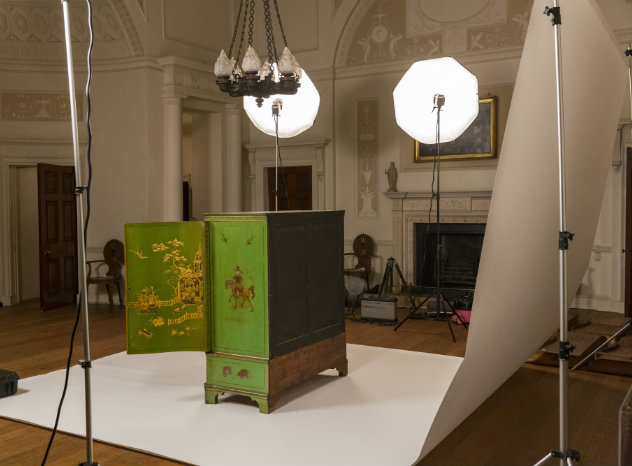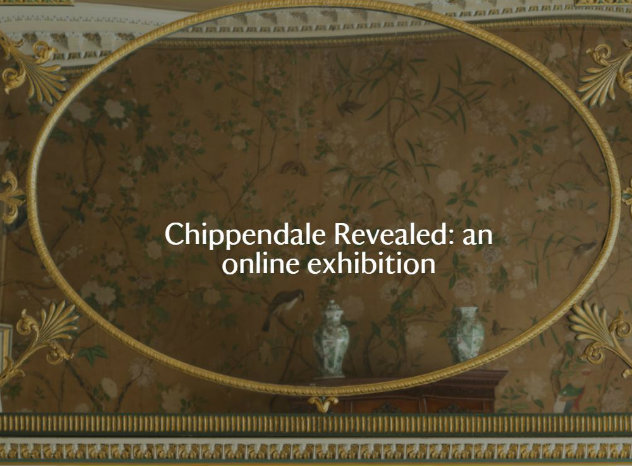These terms are used throughout the exhibition Chippendale Revealed and reflect techniques and materials used in 18th-century furniture-making.
Backstool
A chair without arms; essentially a stool with the rear legs extended upwards to form a back.
Bracket feet
An applied foot extending a short distance away from the corner of the base of a chest of drawers, cabinet or other piece of furniture, generally curved at the free ends and with a mitre at the junction.
Cabriole
A leg in the general shape of an ‘S’, with a pronounced knee, waisted ankle and pronounced foot.
Case furniture
Furniture made with a carcase or case, such as cabinets or presses, which form a compartment - either behind doors or in drawers - for storage.
Castors
Small ‘wheels’ attached to the feet of furniture. Early castors were made of leather or wood; later castors were made of brass.
Chamfer
A chamfer is created by shaving away the corner of a right-angled joint, forming a transitional edge between two faces of an object. A form of bevel, it is created at a 45° angle to two adjoining right-angled faces.
Cockbead
A small convex or half-round projecting moulding, typically used round the edges of drawers; sometime applied to friezes to simulate drawers.
Cornice
The uppermost moulding at the top of a piece of furniture; a finishing moulding.
Crossband
A decorative band of veneer normally applied at the edge of a veneered surface, forming a border, the grain normally running in the opposite direction to the grain of the veneer it abuts.
Dovetail
A form of joint. Used to join two pieces of timber by cutting their edges with reversed wedge-shape projections which fit into one another.
Drawer linings
The boards from which a drawer is formed.
Drawer runners
Pieces of wood attached to the bottom of the front and both edges of the underside of the drawer and upon which the drawer ‘slides’ or runs.
Drawer stop
A piece of timber either glued to the back of a drawer to prevent it being pushed too far into the carcase when closed or a piece of timber glued and pinned near to the front of the dustboard serving the same purpose.
Dustboard
A thin board, generally of softwood, fixed to the rails forming the horizontal partitions between the drawers of a chest.
Escutcheon
An applied – usually metal – decorative plate surrounding a keyhole.
Graduated
Used to describe drawers of different depths, usually getting deeper the lower down a chest they are placed.
Hair cloth/horsehair
Cloth woven from horse hair.
Japanned/japanning
European decoration in imitation of Oriental lacquer.
Lip
Normally the piece of decorative 'show' timber applied in front of a softwood or oak furniture part, typically to a dustboard.
Mouldings
The curves worked along the length of a projecting or receding feature of a piece of furniture, in order to produce light and shade. Also moulded lengths of wood applied to furniture for the same purpose. Also intended to hide or conceal dovetails etc.
Pediment
A decorative feature above the cornice of a cabinet of other piece of furniture, often forming a triangle, though sometimes broken, or scroll-ended.
Seat rail
The pieces of timber which form the seat of a chair, and to which the legs and arm supports (if present) are attached.
Tenon
The end of a piece of wood shaped to fit into a corresponding cavity in another piece of wood; a type of joint.
‘Thread’ Escutcheon
A metal, key-shaped liner inserted into a keyhole and sitting either flush, or slightly overlapping, the drawer front.
Wainscot
A term used in the 18th century, and before, to describe high-grade oak boards, often imported into England.

